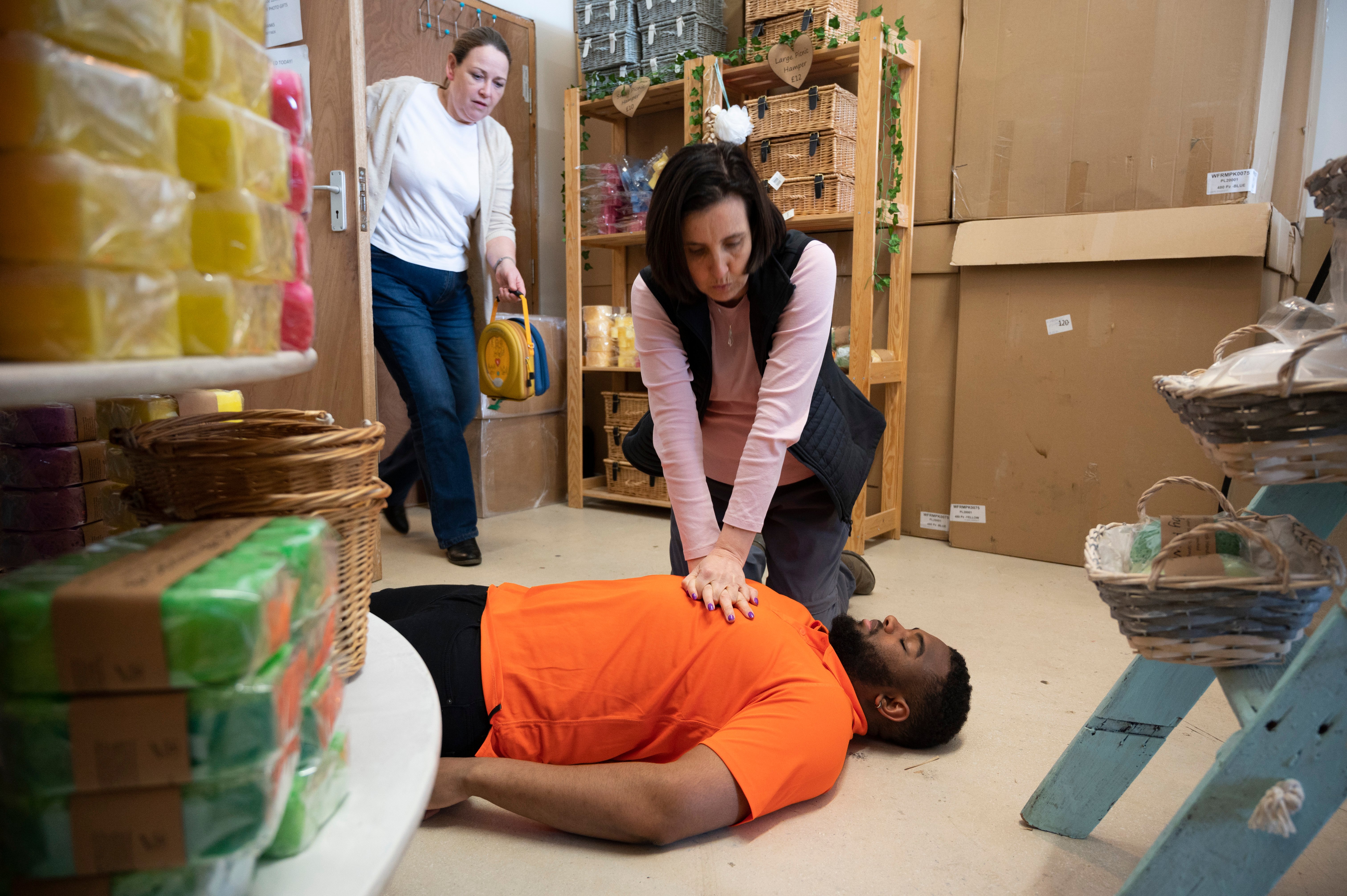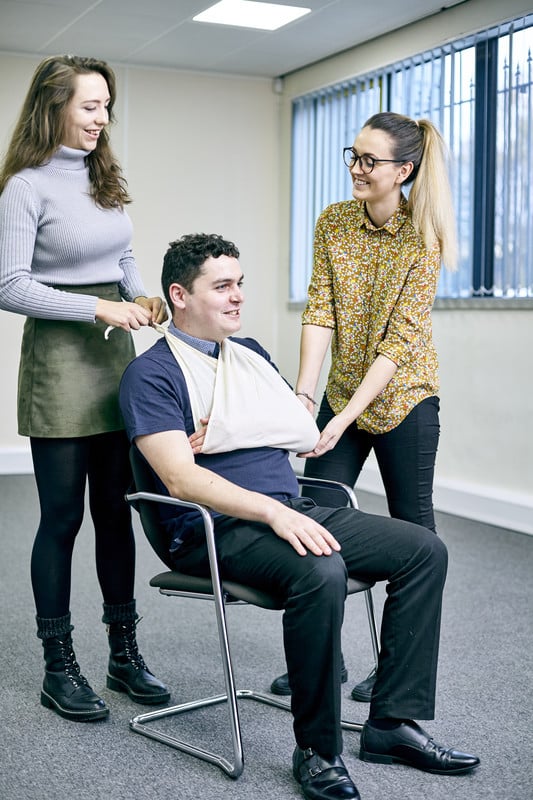The culture of your organisation influences how people behave and how they perform at work – and this includes how they respond to health and safety. A poor health and safety culture can lead to accidents, injuries, health problems – and even damage mental wellbeing. In 2022/23, 35.2 million working days were lost due to work-related ill health and non-fatal workplace injuries. By taking a positive approach to health and safety, you can nurture a culture which minimises accidents at work and prioritises the health and wellbeing of your employees.
This blog sets out the benefits of occupational health and safety measures such as defibrillators (AEDs) in the workplace, and how these contribute to building a culture of safety – especially in a hybrid working world.

Building a culture of safety in the workplace
When you think about building a culture of safety in your workplace, the first thing that may come to mind is protecting the physical health of your workforce. These measures may already be happening in your organisation:
- Investing in first aid courses, mental health at work support, manual handling and fire marshal training so your employees are not only skilled but confident to act on their knowledge.
- Prioritising the placement of first aid kits and AEDs (automated external defibrillators) around the business premises which should be readily accessible for employees and visitors to use if necessary.
But building such a culture around physical wellbeing goes hand in hand with looking after the mental wellbeing of your employees – particularly in a world of remote working. Here’s some best practice suggestions around creating a positive health and safety culture:
- Create an open environment in which employees are encouraged to ask questions about health and safety and wellbeing. Make health and safety part of your everyday conversations amongst your team. Consider the channels of communication available.
- Listen to concerns of employees around health and safety, particularly around mental health where there may be stigma attached to talking openly.
- Encourage mangers to show a positive attitude towards physical and mental health and ask them to prioritise it within their teams through leading by example.
- Celebrate where good health and safety practice and positive wellbeing is thriving in your organisation.
The key to cultivating a culture of safety in the workplace is giving your employees the skills and confidence to act – whether that’s in an emergency, dealing with an accident or illness, or responding to someone struggling with their mental health. A visible way to do this in your workplace is by investing in AEDs and normalising their place in the work environment.
What are the benefits of having defibrillators in the workplace?
An AED is a portable machine that can correct an abnormal heart rhythm by giving an electric shock. You can find them in many public places, such as train stations, shopping centres or schools. They are used in a first aid emergency to help people who are unresponsive and not breathing.

During a cardiac arrest, the heart stops pumping blood around the body to the vital organs. While CPR (cardiopulmonary resuscitation) uses chest compressions to mimic the heart and keep the blood flowing, an AED uses an electric shock to restart the heart. Prompt CPR and defibrillation can more than double the chances of survival if someone has suffered a cardiac arrest. Figures published by the London Ambulance Service show that when an AED was used by a bystander and at least one shock was delivered to patients, the survival rate was 51 per cent higher. However, 2023 research by the British Cardiovascular Society Conference reveals AEDs are being used in just one in ten cardiac arrests where the lifesaving devices are available.
In most first aid situations, CPR and the AEDs work together to increase the chances of returning the heart to a normal rhythm. Defibrillators in the workplace could realistically make a huge difference to your employees.
Readily available defibrillators
According to the Health and Safety (First Aid) Regulations 1981, employers are not required to install a defibrillator within workplaces. However, state-funded schools in England are now expected to do so and the Department for Education is providing AEDs where existing provision is not already in place. Outside the remit of the regulations, many workplaces choose to invest in AEDs as the chance of survival from a cardiac arrest is much higher when a defibrillator is on hand and used within a few minutes after a person becomes unresponsive and not breathing.
Defibrillators in the workplace should be easy to find and accessible at all times. Consideration should be given to storing the AED to maximise accessibility and reduce the risk or theft or misuse. Secure weather-resistant cabinets are a sensible option where the AED needs to be located outdoors. AEDs require no prior training to be used by the public and they could be fully automated (you don’t even have to press a ‘shock button’) or semi-automated (you need to check the area around the patient and then press the button when prompted to do so). However, HSE regulations state that employees must be given appropriate training on any equipment available for them to use in the workplace.
All Red Cross Training first aid courses include training on how to use an AED in an emergency.
Handling a cardiac emergency in the workplace with confidence
What is the difference between a heart attack and a cardiac arrest?
People often get confused about what the difference is between a heart attack and a cardiac arrest and it is vital that you can recognise the signs symptoms and act accordingly.
A cardiac arrest occurs when the heart stops working completely. The casualty will have collapsed and be unresponsive and not breathing.
A heart attack is a blockage of blood to the heart – the person may have persistent, dull and heavy vice-like chest pain, which may spread to their arms, neck, jaw, back or stomach. A heart attack can lead to cardiac arrest so it's important to get emergency help as quickly as possible.
What to do if a colleague is unresponsive and not breathing
If a person in your workplace is unresponsive and not breathing and an AED is available, following these steps before the emergency services arrive will give them the best chance of survival:
- Gently tilt their head back and check for breathing by looking, listening, and feeling for breaths.
- Call 999 immediately or ask someone else to do it. Ask someone to get the AED.
- Give cycles of 30 chest compressions and two rescue breaths.
- Ask a helper to open the AED, turn it on if necessary and follow all its voice prompts.

Read more about how to help someone who is unresponsive and not breathing in our First Aid Heart Skills Pack.
Why a culture of safety is more important in a hybrid world
As companies maintain hybrid working policies in 2024 and beyond, consideration around first aid provision cannot be taken for granted. With more people working primarily from home, and new legislation supporting flexible working, this can lead to fewer first aiders physically present on-site at any given time.
Employers need to find ways of ensuring there are always enough trained first aiders in the workplace, as well as making sure hybrid workers have access to some form of first aid provision. Choosing a leading first aid provider gives your organisation a higher chance of having enough first aiders in your workplace every day. Completing a first aid course with Red Cross Training means your entire team can learn AED and CPR skills using real-life scenarios and equipment. Plus, training even fully remote employees in first aid means they will have enough understanding to be able to treat their own minor injuries and know when to call for emergency help. And, if necessary, they can use their skills outside of work to help friends, family or members of the public.
But remote working doesn’t only affect first aid provision, it’s also had a huge effect on mental wellbeing. In fact, 59% of employees reported they do not regularly feel joy and satisfaction at work. Taking a proactive approach to first aid provision in the workplace helps to create a positive health and safety culture, where employees feel comfortable talking, learning and prioritising health and wellbeing. This, in turn, can help reduce absenteeism, prevent burnout, and build a more productive and efficient workforce – even virtually.
Boost employee wellbeing with Red Cross Training
It is important for all employers to regularly review their first aids needs, not just to ensure you are legally compliant and keep staff physically safe, but also to boost employee wellbeing. Red Cross Training makes it easy to prioritise both the physical and mental health of your teams, with a range of courses suited to your business needs.
Red Cross Training has a customer satisfaction score of 99 per cent and a Trustpilot rating of 4.9/5 (based on 4,278 reviews). Each of our Emergency First Aid at Work, First Aid at Work Requalification and First Aid at Work courses include practical training in CPR and AED use. Learners are encouraged to observe and support one another, before incorporating the AED in a practice scenario in small groups. Our trainers use genuine AED training devices so that the learners have the chance to replicate the operation of this vital piece of equipment as realistically as possible.
Topics: First Aid



